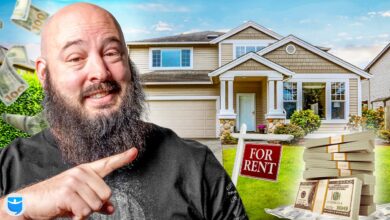
[ad_1]
In recent years, a sizeable amount of criticism has been leveled against what many see as endless sprawl and “lifeless” suburbia that surrounds many American cities. In fact, it happens so often that I’m actually a bit surprised that while the difficulty and opportunity of rural investing comes up fairly often, there isn’t a large amount of discussion regarding the merits and challenges of urban versus suburban investing (although there is certainly some in the BiggerPockets forums).
Regardless, for those who haven’t noticed, amongst urban planners and the growing car-free movement, the suburbs represent a capitalist conspiracy created by ruthless developers and a dastardly plot by General Motors to create an atomized, soulless, car-reliant hellscape Ponzi scheme that has indebted local governments up to their eyeballs and will soon come crashing down catastrophically. A few “anti-car activists” have even gone so far as to commit low-level terrorism, such as deflating random people’s tires while posting threatening letters.
Given real estate investors are rather dependent on the cities they invest in not collapsing, the truth of this matter should be of some interest here. Unfortunately, this topic is quite large, so I will cover it in two pieces.
Here, we will cover the complex origins and unique characteristics of the American suburb. Part 2 will cover its critiques in more depth and look at the viability of suburbs, particularly for real estate investors.
The History of the Suburbs
The biggest problem when critiquing (or defending) the suburbs is that the definition is rather squirrely. Google’s dictionary just defines “suburbs” as “an outlying district of a city, especially a residential one.”
And by that definition, the suburb has existed since the invention of the city. As far back as ancient Jerusalem, Rome, or Persepolis, cities have always had a central district (or several) that is the most dense and then gradually becomes less dense and more residential the further you get from it.
Indeed, this partially mirrors the layout of Medieval castles. The lord’s castle was typically surrounded by the farmland and villages of his serfs. When threatened with an attack, the serfs would retreat to the castle and defend themselves from there.
In other words, the suburb, as defined, is nothing unusual, and criticizing it would be absurd. Indeed, the word “suburb” came into common English speech in the middle of the 18th century, long before the “car-free movement” argues the modern American suburb was created.

Instead, what “smart growth” promoters complain about is the particularly car-centric model of development that became extremely popular following the Second World War. As Strong Towns—an advocacy group critical of suburbia—describes the “suburban experiment” as a model of development that “isn’t defined by the automobile” but “scaled for cars” and “based on the assumptions of abundance and endless growth” while being designed “to accommodate a living arrangement based on automobile travel.”
Think of the sprawling subdivisions of similar-looking houses splitting off from major roads lined with almost identical-looking strip malls, retail outlets, and the like—places where owning a car is effectively mandatory to get around.
This model of development likely found its start near the end of the Great Depression. In 1938, the federal government created Fannie Mae with the express interest of increasing homeownership. Then, after the war, when the last remnants of the Great Depression were finally over, Congress passed the GI Bill, which provided zero-down, low-interest loans for veterans. And given that 16 million Americans served in World War II, this bill applied to an enormous number of people.
The effect it had on homeownership is rather obvious when looking at it graphically.

This was likely the high point of American optimism. The United States was victorious in the biggest war in human history and, unlike the other major victors, wasn’t nearly bankrupt (Britain) or devastated (the Soviet Union). In fact, in 1945, the United States accounted for roughly half of the world’s GDP! (Today, it’s fallen to 24%.)
The term “American Dream” was popularized in 1931 but came into its own in the late ’40s and early ’50s. The image of every American family having their suburban home with a big backyard perfect for barbecues, with their trusty Chevy sedan in the driveway, might be a bit stereotypical of the times, but it definitely resonated back then.
There were certainly simmering issues just underneath the surface. After all, the civil rights movement was just getting started, and the counterculture movements of the 1960s were just a decade away. But economically, Americans had never done better, and the suburban home represented the epitome of it.
A Conspiracy to Create the Suburbs?
What I’ve described is true, although only part of the story. In fact, some would argue it’s simply a sanitized account that leaves out the critical factors. As noted, another account sees the suburb as a conspiracy of rapacious capitalists to increase profits to the detriment of the inhabitants and the city’s long-term viability.
The most popular of these is the General Motors streetcar conspiracy, popularized in the 1996 documentary Taken for a Ride and film Who Framed Roger Rabbit?
The allegation goes like this: General Motors bought up the numerous electric streetcars you see in footage from the 1920s and 1930s. They then started their own bus line called National City Lines. Then, they started removing the streetcars one by one so that the only mode of public transportation remaining were their buses.
Thus, there was less public transportation, and at the same time, those pesky streetcar tracks were out of the way, which made more room for cars. This also meant GM provided the carrot and stick to increase consumer demand for automobiles.
The smoking gun to this theory is supposedly that GM was convicted in 1949 of conspiracy. However, this is where the theory—at least for the most part— falls apart. As Mark Henricks noted, the conspiracy GM was convicted of was for “conspiring to monopolize the market for transportation equipment and supplies sold to local bus companies,” not destroying public transportation in the United States.
Cliff Slater wrote a 20-page takedown of the streetcar conspiracy in Transportation Quarterly, which pretty thoroughly discredits it. First, he notes that the story had only first started circulating in 1974 (almost three decades after it supposedly happened) when a newly hired antitrust attorney for the U.S. Senate named Bradley Snell stated that the government had charged “…General Motors and allied highway interests for their involvement in the destruction of 100 electric rail…systems… throughout the country.”
Again, GM had actually been convicted of trying to monopolize transportation equipment and supplies. Snell’s arguments were debunked in the same Senate hearing by UCLA professor George Hilton, the Federal Transit Administration, and the “pro-rail” New Electrical Railway Journal, but that didn’t prevent those accusations from taking on a life of their own.
What really happened to the streetcars was much more mundane. As Slater explains:
“The streetcar made no significant technical advances during the 1920s, whereas the motor bus changed beyond recognition. The motor bus was not taken seriously until about 1920, but from then on, growth was explosive. Manufacturers made significant improvements to chassis and engines during this time. The improvements in speed, handling, and comfort made buses less costly and more comfortable. America’s cities were rapidly paving their city streets, and this helped the bus.”
Streetcar ridership, on the other hand, peaked in 1920 at 13.8 billion before declining to 11.8 billion in 1929. National City Lines didn’t even start until 1936, at which point, over 40% of cities relied exclusively on buses for public transportation.
Thus, we see streetcar ridership fall below bus ridership as early as 1922 and to less than half by 1948.

Many companies other than GM owned streetcars, but all of these still decided to eventually remove them. Several cities, such as San Francisco, had municipally owned streetcars and still chose to remove them, as did many other countries, like the United Kingdom.
Slater finishes his case by summarizing the research on the cost efficiencies of streetcars versus buses:
“In 1936, Fortune magazine reported, ‘The average large bus can be operated for about four-fifths the cost of running a trolley.’ In the United Kingdom, ‘By the thirties, costs per passenger on buses were comparable to those on (streetcars), instead of more than twice as high as they had often been around 1920.’
“Buses continued to reduce their costs relative to streetcars and electric trolleys, and so generally replaced them. By 1949, San Francisco would report their average hourly operating costs as $4.50 for buses versus $7.11 for streetcars—37% less. When Philadelphia changed from streetcars to buses in 1961, they reported their operating costs for rail lines as a prohibitively high 93.5¢ per mile versus the cost of the bus at 47.7¢ per mile—nearly twice as much.”
I like a good conspiracy theory as much as the next guy, but this one falls flat. It was not the destruction of the streetcars that increased the number of cars, but the increased availability, affordability, and efficiency of cars (and buses) that made the streetcars mostly obsolete.
One of the major advantages cars had over streetcars (or most other public transit, for that matter) is that they are not bound to a fixed line and thereby remove the problem of only having transport for part of your trip. Even buses have much more flexibility in their routes than streetcars. Thus, other than in very dense urban areas, the streetcar no longer made sense.
How Policy Did (Help) Create the Suburbs
Yet, there were corporate initiatives and government policies that contributed to the rise of the suburbs. The main one from the government was the Interstate Highway System, which began in 1956 and was largely motivated so troops and military equipment could be moved from one side of the country to the other in case of a Red Dawn scenario.
Cold War paranoia aside, the interstate system made it not only much easier to travel by car around the country but also much easier to traverse urban sprawl, i.e., to live in the suburbs and commute to the city for work.
The highways also required the widespread use of eminent domain to confiscate private property (with compensation) and build roads where entire neighborhoods once were, uprooting entire communities.
On local levels, many city planners were also pushing toward a more car-centric model of development. New York City Parks Commissioner Robert Moses epitomized this trend by building all sorts of roads, bridges, and tunnels throughout New York City, and famously got into a heated debate with urban activist Jane Jacobs regarding urban planning in general, Washington Square Park in particular.
All of this road construction directly followed the urban renewal of the 1940s, which culminated in the National Housing Act of 1949. The legislation authorized the construction of 810,000 public housing units, but there was a dark side, namely slum clearing. As an article on Smart Cities Dive says:
“The government fell far short of its goal to build 810,000 units of new public housing by 1955. In fact, the Act’s urban redevelopment programs actually destroyed more housing units than they built.”
Such a program also uprooted many communities, pushing many people out into the expanding suburbs. Indeed, more conspiracy theories follow urban renewal given the embarrassing performance, with some black leaders as well as leaders of some predominantly Catholic ethnicities believing it was a policy to break up the ethnic strongholds one thinks of when looking back at that period (i.e., Little Italy, Chinatown, etc.) to reduce these group’s political power. But that’s a bit of a tangent.
Instead, let us turn to the business side of the equation, most notably with a man named William Levitt.
As USHistory.org notes:
“Contracted by the federal government during the war to quickly build housing for military personnel, Levitt applied the techniques of mass production to construction. In 1947, he set out to erect the largest planned-living community in the United States on farmland he had purchased on Long Island, New York. Levitt identified 27 different steps to build a house. Therefore, 27 different teams of builders were hired to construct the homes.”
This means William Levitt became a sort of Henry Ford-like figure, bringing an assembly-line approach to home construction. While his basic homes weren’t anything special (the first group were all two-bed, one-bath, with no basement), they were immensely affordable, especially when paired with the aforementioned GI Bill.
Indeed, each home in Levittown sold for a mere $8,500 (even today, only about $111,000)!
These types of developments became the model for developers across the country. Thus, suburban homes were and have continued to be significantly cheaper than urban properties. Given the baby boom of the late ’40s and ’50s, families needed more space for their kids, too. This provided another incentive for suburbanization, as square footage was cheaper in the suburbs.
Suburban infrastructures also began to fill out. For example, the first American mall—the Southdale Mall—opened in 1956.
As noted, the idea of the American Dream grew in prominence, as well as phrases like “keeping up with the Joneses” and even the idealization of the white picket fence. Owning a home in an American suburb became synonymous with having become a productive member of the American middle class.
1960s Riots and White Flight
The last major cause of the suburbanization in the United States was a combination of increased crime during the ’60s and 70s and the urban riots of the mid-to-late ’60s in places such as Watts (1965), Detroit (1967) and throughout the country following the assassination of Martin Luther King Jr.
The 1960s certainly saw some major accomplishments, like the Civil Rights Act of 1964 and the Voting Rights Act of 1965. Unfortunately, it also had some not-so-good things, including a soft-on-crime approach and the introduction of welfare programs that saw subsequent skyrocketing dependencies and fatherlessness rates.
For these and a variety of other reasons—including a more youthful demographic after the postwar baby boom—crime skyrocketed in the mid-’60s. The murder rate more than doubled from 1960 to 1972, and the urban murder rate increased threefold. Other crimes increased at a similar rate.

Given this, many people with the means fled the cities. Since most of those with means were white, this became known as white flight.
This also represented a capital flight. The combination of fewer people, more crime, and less money led to increased urban blight and deterioration in the quality of the schools. These factors increased the “push” incentive to leave for the suburbs, while the affordability and desirability of Levittown homes and others like them provided the “pull.”
This process of urban decay culminated in New York City requiring a federal bailout while teetering on the edge of bankruptcy in 1975. Indeed, the urban decline permeated the pessimism of the 1970s in everything from films like Taxi Driver to Jimmy Carter’s famous (infamous?) malaise speech.
This trend didn’t really begin to reverse until crime began to decrease and gentrification increased in the 1990s. This trend has flipped once again in recent years and is notably ignored by many activists for urban densification.
Final Thoughts
The American suburbs are not just the less-dense area that surrounds the city center, as in cities from years past or even in many other countries today. The United States’ large land mass, along with the car and a variety of cultural, political, and business decisions, have contributed to its unique character and growth.
A discussion regarding the desirability and sustainability of the suburbs, as well as their likely future and prospects for real estate investors, will be addressed in Part 2.
Ready to succeed in real estate investing? Create a free BiggerPockets account to learn about investment strategies; ask questions and get answers from our community of +2 million members; connect with investor-friendly agents; and so much more.
Note By BiggerPockets: These are opinions written by the author and do not necessarily represent the opinions of BiggerPockets.
Source link




